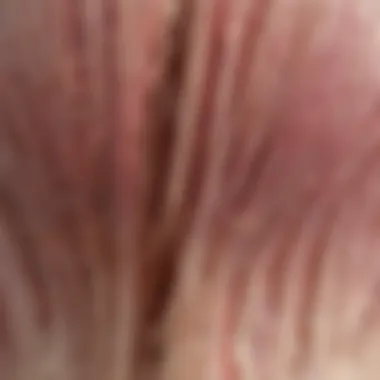Effective Methods to Combat DHT in Hair Follicles


Intro
Understanding dihydrotestosterone (DHT) is pivotal for anyone concerned with hair loss, particularly androgenetic alopecia. DHT is a derivative of testosterone and plays a key role in the miniaturization of hair follicles, leading to thinning and eventual loss of hair. This article delves into various methods to address the presence of DHT in order to support healthier hair growth.
Research Overview
Summary of Key Findings
Recent studies have highlighted the connection between DHT levels and hair follicle health. High levels of DHT can lead to reduced hair growth cycles and the eventual death of hair follicles. Research consistently points to DHT's ability to bind with androgen receptors in hair follicles, impacting hair density and overall hair viability. Additionally, understanding genetic predispositions emphasizes the individual variability in response to DHT treatment methods.
Relevance to Current Scientific Discussions
The challenge of DHT and its impact on hair health is central to ongoing discussions in dermatology and endocrinology. New research continues to emerge on alternative treatments, including medication, natural remedies, and lifestyle modifications. An informed approach can significantly enhance the effectiveness of these methods in combating the effects of DHT.
Methodology
Research Design and Approach
This section explores various methodologies that aim to analyze the effects of DHT on hair follicles. Studies often utilize both qualitative and quantitative approaches, combining clinical trials, observational studies, and biochemical analyses. The goal is to understand the complex interactions between DHT levels and hair follicle health.
Data Collection and Analysis Techniques
Data is typically gathered through patient surveys, clinical evaluations, and laboratory tests measuring DHT levels. Researchers analyze the collected data to identify patterns and correlations with effective treatment methods. Statistical tools are employed to ensure that findings are robust and statistically significant.
Overview of Dihydrotestosterone
Understanding dihydrotestosterone, or DHT, is essential for comprehending its role in hair health. This hormone, derived from testosterone, has significant implications for hair loss, particularly androgenetic alopecia. The exploration of DHT is critical because it offers insights into prevention and treatment strategies that are relevant for many facing hair thinning or loss. This section elucidates the foundational concepts of DHT, allowing readers to grasp how it influences hair follicles and their growth cycle.
Definition of DHT
Dihydrotestosterone is a potent androgen, a type of male hormone. It is formed when the enzyme 5-alpha reductase converts testosterone into DHT. DHT's chemical structure is similar to testosterone, but it binds more effectively to androgen receptors in the body. This potency is what makes DHT a significant player in androgenetic alopecia. It is important to understand that while DHT plays a role in male and female developmental processes, its overproduction can induce negative effects on hair follicles.
Role of DHT in Hair Loss
DHT has a direct impact on hair loss. It binds to androgen receptors located on hair follicles, particularly those on the scalp. This binding triggers a process known as follicular miniaturization. Over time, hair follicles shrink, resulting in thinner hair strands. Eventually, they may stop producing hair altogether. This sequence of events is what many refer to as male and female pattern baldness. Therefore, reducing the levels of DHT in the scalp may help in preserving hair growth and combating hair loss.
Physiological Functions of DHT
While DHT's role in hair loss is well-documented, it also serves various physiological functions in the human body. It contributes to the development of male characteristics during puberty and is involved in prostate health. DHT influences libido and has effects on muscle mass retention. Nevertheless, its deleterious effects on hair follicles have raised concerns among many seeking effective treatments for hair loss. Hence, acknowledging these broad functions of DHT helps formulate targeted strategies for managing its levels without compromising other critical bodily functions.
Mechanism of DHT Interaction with Hair Follicles
Understanding the mechanism of dihydrotestosterone (DHT) interaction with hair follicles is crucial in addressing hair loss. DHT is a potent androgen that affects the size and function of hair follicles. Its influence can lead to the miniaturization of hair follicles, which contributes to thinning hair and eventual baldness. By grasping these interactions, one can explore effective strategies to mitigate DHT's adverse effects on hair health.
Androgen Receptors
Androgen receptors play a pivotal role in the interaction between DHT and hair follicles. These receptors are proteins located in various tissues, including the scalp. When DHT binds to these receptors, it expands the activity of androgens within the follicles. This binding triggers a series of biochemical processes that may eventually lead to reduced hair growth. The density of androgen receptors in hair follicles varies among individuals, providing insight into why some people are more susceptible to DHT than others.
By inhibiting the action of androgen receptors, treatments aimed at blocking DHT can help maintain healthier hair. Medications such as finasteride specifically target this pathway, reducing the effectiveness of DHT in binding to its receptors. This change can allow for a reversal or slowing down of hair loss, making it a valuable approach in DHT management.
Impact on Hair Growth Cycles
DHT's interaction with hair follicles disrupts the natural growth cycles of hair. Normally, hair grows through phases: anagen (growth), catagen (transition), and telogen (rest). High levels of DHT can shorten the anagen phase, leading to weaker hair and an increase in the proportion of hair in the telogen phase. As more hair follicles enter the resting phase prematurely, the result is noticeable thinning and hair loss.
This cycle distortion not only affects existing hairs but may reduce the number of new hairs that emerge. This chronic suppression can lead to a situation where hair thinning becomes increasingly apparent. Treatments that stabilize or extend the anagen phase may mitigate these effects, promoting healthier and fuller hair.


Inflammatory Responses
Inflammation is another significant aspect of DHT's interaction with hair follicles. DHT can initiate inflammatory processes, which may exacerbate follicle sensitivity and lead to an increased rate of hair loss. Factors such as oxidative stress and inflammatory cytokines contribute to this condition. The presence of DHT may trigger immune responses that harm hair follicle cells directly, leading to further complications in hair regeneration.
Managing inflammation through targeted treatments can therefore play a vital role in reducing DHT's negative effects on hair. Anti-inflammatory medications or natural supplements with anti-inflammatory properties can potentially support the health of hair follicles.
"Addressing the mechanisms underpinning DHT's interaction with hair follicles can significantly aid in reducing hair loss and enhancing hair health."
In summary, a deep knowledge of how DHT interacts with hair follicles is vital for individuals looking to combat hair loss. By focusing on androgen receptors, recognizing the impact on hair growth cycles, and managing inflammatory responses, one can effectively navigate the challenges posed by DHT and seek to preserve hair health.
Pharmacological Approaches to Reduce DHT
Pharmacological methods to address Dihydrotestosterone (DHT) levels hold significant ground in the management of androgenetic alopecia. These approaches aim to inhibit the production of DHT or block its effects on hair follicles. By focusing on pharmacological strategies, individuals can navigate viable solutions, balancing effectiveness and potential side effects.
In this section, we will explore the main classes of drugs, including 5-alpha reductase inhibitors, topical DHT blockers, and natural supplements. Each choice carries unique benefits and considerations relevant to personal hair health.
5-alpha Reductase Inhibitors
5-alpha reductase inhibitors function by blocking the enzyme responsible for converting testosterone into DHT. These medications are often recommended due to their direct impact on reducing DHT levels.
Finasteride
Finasteride stands out as a well-known treatment option for hair loss. Its primary role is to inhibit the type II 5-alpha reductase enzyme. This specific action lowers DHT production significantly. The key characteristic of Finasteride is that it is taken orally and is available by prescription.
Its popularity stems from extensive clinical research backing its effectiveness. Notable benefits include a significant reduction in hair loss in many users, especially in the early stages of hair thinning. However, it is crucial to consider potential side effects, including sexual dysfunction and mood changes, which some users report.
Dutasteride
Dutasteride is similar to Finasteride but is more potent. It inhibits both type I and type II 5-alpha reductase enzymes. This broad action makes it an attractive option for individuals who may not have seen results with Finasteride.
The advantage of Dutasteride lies in its ability to reduce DHT levels more rapidly and extensively than Finasteride. Nonetheless, this power comes with potential disadvantages such as an increased incidence of side effects. Users should carefully weigh these factors when considering its use.
Topical DHT Blockers
Topical DHT blockers represent a non-systemic approach to managing DHT levels. These products are applied directly to the scalp and include various formulations with ingredients known to interfere with DHT activity locally.
The benefit of topical treatments is their targeted action, potentially resulting in fewer systemic side effects compared to oral medications. Users should look for products that incorporate scientifically backed components designed to combat DHT effectively.
Natural Supplements for DHT Reduction
Natural supplements offer an alternative or complementary route in the fight against elevated DHT levels. Some commonly used natural products include:
- Pumpkin Seed Oil: Known for its potential benefits in promoting hair growth, pumpkin seed oil may inhibit DHT action at the receptor level. It is prized for its rich nutrient profile, contributing to overall hair health without significant side effects.
- Saw Palmetto: This herb is one of the most studied natural DHT blockers. Saw palmetto is believed to work by inhibiting the 5-alpha reductase enzyme. Its use in supplements helps provide a natural approach to managing hair loss. Properties include a generally favorable safety profile, although scientific evidence remains mixed.
- Zinc: While often recognized for its role in overall health, zinc may also support hair health by modulating testosterone levels, thereby indirectly impacting DHT. Being a mineral, it is easy to incorporate via diet or supplements.
Each of these natural remedies offers a different mechanism of action, and selecting the right one can depend on individual response and health status.
When considering pharmacological approaches, consulting healthcare professionals for tailored advice and oversight is vital for optimizing results and minimizing side effects.
Dietary Modifications to Manage DHT Levels
Dietary modifications play a crucial role in managing dihydrotestosterone (DHT) levels in the body, thus impacting hair health. Changing one’s diet can help either elevate or lower DHT levels, depending on the types of food consumed. The significance of making informed food choices is demonstrated through understanding which foods can contribute to increased DHT production and which can facilitate its reduction. Dietary strategies can be both a practical and effective approach in the quest for healthier hair and the prevention of hair loss related to high DHT.
Foods to Avoid
Processed Foods
Processed foods are prevalent in modern diets but harbor significant downsides when it comes to DHT management. These foods often contain unhealthy fats, preservatives, and additives, which can disrupt hormonal balance. The high glycemic index of many processed foods can lead to insulin spikes, potentially increasing androgen levels and, consequently, DHT. Avoiding such items is beneficial as it helps maintain a more stable hormonal environment, which is conducive to hair health.


Key characteristics of processed foods include their convenience and ubiquitous nature. While they often provide quick meal solutions, they generally compromise nutritional value.
Sugar-Rich Foods
Sugar-rich foods also warrant avoidance for those looking to manage DHT levels. The connection between high sugar intake and hormonal imbalances is well-documented. Consuming excessive sugar can cause fluctuations in insulin, which may lead to an upsurge in androgen levels, ultimately elevating DHT. Hence, steering clear of sugary snacks and beverages is advisable.
These foods are typically enticing and widely available, yet they pose threats to overall health. The unique feature of sugar-rich foods is their addictive nature, making them hard to resist despite potential health consequences.
Beneficial Foods
Vegetables and Fruits
In contrast, vegetables and fruits are excellent additions to a diet aimed at reducing DHT. They are packed with vitamins, minerals, and antioxidants, which support overall health and may aid in hormonal balance. Specifically, leafy greens and colorful fruits provide nutrients that can help limit the formation and activity of DHT.
The key characteristic of vegetables and fruits is their high fiber content, which plays a role in maintaining a healthy gut microbiome. A healthy gut can influence hormonal regulation positively, making these foods a beneficial choice for DHT management.
Healthy Fats
Healthy fats also play a significant role in managing DHT levels. Foods rich in omega-3 fatty acids, such as salmon, walnuts, and flaxseeds, can reduce inflammation and help regulate hormone levels. These fats are essential for maintaining cellular health and supporting the hormonal synthesis process.
The important aspect of healthy fats is their role in promoting cardiovascular health, which can indirectly support hormonal balance. Unlike saturated fats and trans fats commonly found in processed foods, these fats provide a stabilizing influence in the diet.
Herbal Remedies in Diet
Incorporating herbal remedies into one’s diet can provide additional support for managing DHT levels. Herbs such as saw palmetto and green tea extract are known for their potential to inhibit the enzyme 5-alpha reductase, which converts testosterone into DHT. Including these herbs in everyday meals—whether as teas or supplements—can augment dietary efforts to manage DHT levels.
These modifications, both in terms of avoiding detrimental foods and embracing beneficial ones, can significantly impact DHT levels and overall hair health. The intricate balance of nutrients in a person's diet can either foster or hinder hair growth, underlining the importance of informed dietary choices.
Lifestyle Changes to Decrease DHT Production
Lifestyle changes play a pivotal role in managing DHT production, thus contributing to hair health. Each individual's body reacts differently to DHT, so it's essential to incorporate personalized strategies to mitigate its effects. Making thoughtful adjustments in daily routines can potentially lower DHT levels and improve hair growth outcomes.
Stress Management
Meditation Techniques
Meditation techniques serve as an effective tool for managing stress. High stress levels can lead to increased DHT production. Mindfulness meditation and focused breathing exercises can help calm the mind and reduce anxiety. One significant characteristic of meditation is its ability to lower cortisol levels, which is beneficial because cortisol can influence DHT pathways. As people adopt meditation, they often find improvements in overall well-being, which can indirectly assist in maintaining healthier DHT levels.
However, establishing a meditation practice can take time, and not everyone experiences immediate benefits. It requires commitment and introspection, which may deter some individuals. Despite this, the advantages of incorporating meditation into a lifestyle are compelling for those aiming to manage DHT effectively.
Physical Activity
Physical activity is another critical factor in stress management that directly impacts DHT production. Regular exercise can help regulate hormone levels and maintain a balanced metabolic rate. A key characteristic of physical activity is its role in enhancing blood circulation, which promotes oxygenation of hair follicles and overall scalp health. Activities such as cardiovascular workouts, weight training, and yoga can significantly reduce stress and, consequently, DHT levels.
While exercise is beneficial, one must consider individual limitations. Some may find it challenging due to time constraints or physical limitations. Nonetheless, the unique advantage of exercise is its multifaceted approach—it aids not just in stress reduction but also in promoting physical health, which is essential for holistic well-being.
Sleep Hygiene
Sleep hygiene is crucial for regulating hormone levels, including DHT. Quantity and quality of sleep can affect how the body produces hormones. Establishing a regular sleep schedule, creating a tranquil sleeping environment, and limiting screen time before bed are all practical steps to enhance sleep quality. Proper sleep supports physical recovery and prevents hormonal imbalances that can elevate DHT. Individuals who struggle with insomnia or irregular sleep patterns should consider consulting a healthcare provider for advice tailored to their specific needs.
Avoiding Environmental Toxins
Environmental toxins can disrupt hormonal balance, contributing to increased DHT levels. Individuals should be conscious of their surroundings and reduce exposure to harmful chemicals found in many household products, cosmetics, and even skincare items. Opting for natural, organic alternatives can help mitigate this risk. A notable disadvantage is the increasing difficulty in finding truly natural products, given the prevalence of synthetic options.
In summary, implementing these lifestyle changes can serve as a proactive means to manage DHT levels. By focusing on stress management, sleep hygiene, and minimizing toxin exposure, individuals can foster a healthier environment for their hair follicles. Ultimately, these methods empower individuals to take control of their hair health in a more informed and thoughtful manner.


Alternative Treatments for DHT Management
Alternative treatments for managing dihydrotestosterone (DHT) offer insights beyond standard pharmacological approaches. These methods cater to individuals who may prefer non-invasive or less conventional routes to tackle hair loss associated with DHT. Understanding these treatments is vital as they can provide different benefits and considerations that enhance overall hair health. By exploring these options, individuals can make informed decisions tailored to their specific needs.
Low-Level Laser Therapy (LLLT)
Low-Level Laser Therapy has gained recognition in hair restoration for its non-invasive nature. LLLT utilizes laser light to stimulate hair follicles, promoting growth and enhancing follicle health. The therapy works by increasing blood circulation to the scalp, which can help revive dormant hair follicles affected by DHT. Patients often find this method appealing due to its safety and minimal side effects compared to more aggressive treatments. Importantly, those considering LLLT should seek certified clinics or professionals, ensuring the technology is up to date and effective.
Scalp Micropigmentation
Scalp Micropigmentation involves tattooing tiny dots on the scalp, mimicking the appearance of hair follicles. This technique acts as a cosmetic solution to create the illusion of fuller hair. As a non-surgical option, it is particularly suitable for individuals looking to restore their confidence without undergoing extensive procedures. It is essential to choose experienced practitioners, as the quality of work significantly influences the overall appearance and satisfaction. The longevity of results typically lasts for several years and may require touch-ups, which should be factored into long-term planning.
Transplant Options
Hair transplant options represent the most permanent solution for hair loss. Techniques such as Follicular Unit Extraction (FUE) and Follicular Unit Transplantation (FUT) are common. These methods involve relocating healthy hair follicles from unaffected regions to areas suffering from DHT-related loss. While effective, candidates for hair transplants must be aware of several considerations. Cost is a significant factor, as these procedures can be expensive. Additionally, outcomes can vary based on individual health factors and the skill of the surgeon. Ensuring that expectations are realistic is crucial pre-surgery.
In summary, alternative treatments like Low-Level Laser Therapy, Scalp Micropigmentation, and hair transplant options provide various options for managing DHT effects on hair follicles. Each comes with its own set of benefits and considerations, demanding careful thought and research by potential candidates.
Ultimately, these treatments should be considered among the broader context of strategies to manage DHT levels, allowing for a personalized approach to hair health.
Importance of Consultation with Specialists
Understanding and managing dihydrotestosterone (DHT) levels in relation to hair health require a well-informed approach. Consultation with specialists is crucial for individuals dealing with hair loss or other related issues. Specialists possess targeted knowledge and experience that can greatly influence treatment success. This section discusses the specific roles of dermatologists and endocrinologists, highlighting their importance in the management of DHT-related hair issues.
Role of Dermatologists
Dermatologists are medical professionals who specialize in skin, hair, and nail disorders. Their expertise is vital for diagnosing hair issues that arise from DHT levels. When patients consult dermatologists for hair loss, they undergo thorough evaluations. This may include physical examinations and possibly skin biopsies to assess the condition of hair follicles.
Key Responsibilities of Dermatologists:
- Diagnosis of Hair Loss Types: Dermatologists differentiate between various forms of hair loss, such as androgenetic alopecia and other forms that may not be related to DHT.
- Medical Treatments: They prescribe medications such as 5-alpha reductase inhibitors to mitigate the effects of DHT on hair follicles.
- Topical Treatments: Dermatologists may recommend topical solutions that help block DHT or promote hair growth. They can advise on the effective use of products like minoxidil.
- Monitoring Progress: Regular follow-ups with a dermatologist can help track the effectiveness of treatments, allowing for adjustments as needed.
Their insights help patients make educated choices about their hair loss treatments and can lead to early intervention.
Endocrinologists and Hormonal Assessment
Endocrinologists focus on hormonal balance and its effects on the body. DHT is a powerful androgen, and understanding how it interacts with other hormones is essential for comprehensive hair loss management. Consulting an endocrinologist can bring fresh perspectives to hair loss treatment.
Reasons to Consult an Endocrinologist:
- Hormonal Imbalance Identification: They can assess overall hormonal levels, not just DHT, providing a broader picture of potential causes of hair loss.
- Advanced Testing: Endocrinologists perform blood tests to determine the levels of testosterone, DHT, and other relevant hormones, giving insights into individual conditions.
- Tailored Treatment Plans: Based on hormonal assessments, endocrinologists can suggest treatments that target underlying hormonal issues rather than just symptoms.
- Preventing Recurrence: Their involvement might help in identifying other health issues related to hormone levels, which can prevent future problems.
Consulting specialists like dermatologists and endocrinologists is essential for tailored and effective treatment strategies to manage DHT's impact on hair health.
In summary, specialists play a key role in navigating the complexities of hair loss related to DHT. Their knowledge and experience allow for effective diagnostic measures, targeted treatments, and ongoing care tailored to individual needs.
Future Directions in DHT Research
Research related to dihydrotestosterone (DHT) is dynamic and evolving. Understanding the future directions in DHT research can lead to more effective treatments for androgenetic alopecia and other conditions related to elevated DHT levels. As science advances, there are several key areas worth exploring that can potentially reshape our understanding and management of DHT.
Genetic Factors and DHT Sensitivity
Genetic predisposition plays a crucial role in how individuals respond to DHT. Variations in androgen receptor genes can determine sensitivity levels to DHT, affecting one’s likelihood of experiencing hair loss. Ongoing research into these genetic factors may reveal who is at higher risk and could inform personalized treatment strategies. Genetic testing could become a valuable tool in the future, enabling healthcare professionals to tailor interventions based on an individual’s specific genetic makeup. Understanding the genetic markers associated with DHT sensitivity will allow for a more strategic approach to hair loss prevention.
Advancements in Pharmacotherapy
Pharmacotherapy is a critical area within DHT research. Current treatments, like finasteride and dutasteride, inhibit the enzyme that converts testosterone to DHT. Future developments may lead to new generations of DHT inhibitors with improved efficacy and fewer side effects. Research into dual-action drugs targeting both DHT reduction and promoting hair growth could also be on the horizon. Moreover, personalized medicine might evolve, where medications are tailored to suit patient profiles, improving results in managing DHT-related conditions effectively.
Emerging Technologies in Hair Restoration
Technological advancements in hair restoration are promising. Techniques such as hair cloning and stem cell therapy are being explored as potential ways to combat the effects of DHT on hair follicles. Emerging technologies could offer long-term solutions that not only address existing hair loss but also prevent further thinning induced by DHT. These innovative methods may work in conjunction with existing treatments to enhance overall hair restoration outcomes.
The continuing exploration of DHT and its implications on hair loss can lead to groundbreaking developments in managing hair health effectively.



